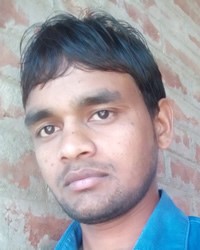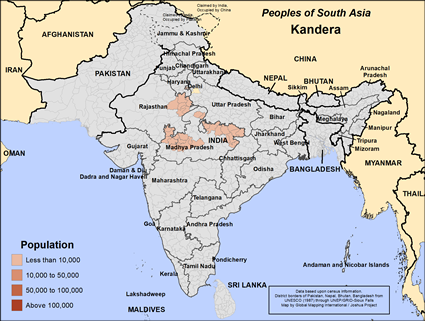Kandera in India

Photo Source:
Anonymous
|

Map Source:
People Group data: Omid. Map geography: UNESCO / GMI. Map Design: Joshua Project
|
| People Name: | Kandera |
| Country: | India |
| 10/40 Window: | Yes |
| Population: | 20,000 |
| World Population: | 20,000 |
| Primary Language: | Hindi |
| Primary Religion: | Hinduism |
| Christian Adherents: | 0.00 % |
| Evangelicals: | 0.00 % |
| Scripture: | Complete Bible |
| Ministry Resources: | Yes |
| Jesus Film: | Yes |
| Audio Recordings: | Yes |
| People Cluster: | South Asia Hindu - other |
| Affinity Bloc: | South Asian Peoples |
| Progress Level: |
|
Introduction / History
Initially, they were a relatively small group known for their skill in archery. Over time, they expanded their expertise to include the operation and production of artillery. The Kanderas trace their origins to Rajasthan and Bundelkhand, with a significant presence in the Ajmer-Merwara province. Historically, they played a crucial role in producing gunpowder, iron missiles, and operating cannons in the Indian armies. The term "Kandera" is derived from "Kandir," associated with arrows, while "Hawaidar" refers to a maker of fireworks. They were local artillerymen. The community also has a historical connection to cotton ginning, a profession some Kanderas chose due to challenges in securing employment in native armies during the Mughal invasion. According to their traditions, their ancestor, Raja Kanakpal Singh of Chittor, settled at Amer in Samvat 1228.
His dynasty ruled over Amer for a considerable period. However, one of his grandson's daughters, Shakuntala, faced complications due to her love marriage with a Rajput, which was not accepted by her father. Subsequently, she was married to another Rajput, leading to a conflict with Sultan Alauddin Khalji. The Rajputs were defeated, and some converted to Islam, taking up cotton ginning, while others dispersed to different regions. This historical event contributed to certain Rajputs facing challenges in maintaining their social status and finding employment in their traditional roles, leading to their classification as other backward classes in some Indian states.
The Kanderas were also associated with the Ajmer-Merwara province, where Kadera served as the capital in the Rathore Rajput dynasty in 1811. During that time, Lal Singh, the Thakur of Kadera, ruled over the region.
What Are Their Lives Like?
The Kandera community is organized into 36 clans, and they follow a practice known as clan exogamy. Within the Hindu tradition, individuals adopt various surnames, including but not limited to Kandera, Kadera, Kandere, Rajput, Karan Rajput, Nagar, Golandaz and their gotras. The diversity of surnames used poses a challenge in accurately identifying members of the community.
What Are Their Beliefs?
The community is evenly divided between Hindu and Muslim segments, with a notable absence of intermarriage between these two groups.
What Are Their Needs?
There are few if any Christian believers in the Kandera homeland. They need Christ followers to go to them as his ambassadors.
Prayer Points
Pray that God will send culturally-sensitive missionaries who will show them the way to the cross.
Pray for a Disciple Making Movement to flourish among this people group in the near future.
Pray for the Kandera people to be blessed with peace, joy and spiritual prosperity as they follow Jesus Christ.